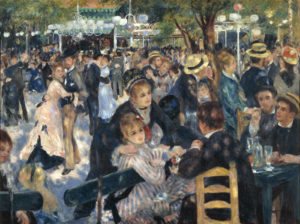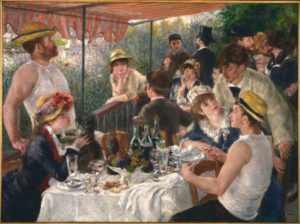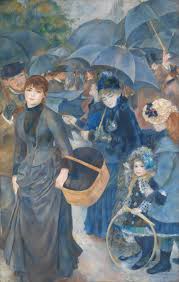Of Course He Doesn’t

Pierre Renoir, Bal du Moulin de la Galette, 1876, oil on canvas
Someone recently got another of his serial 15 minutes of fame organizing a Renoir protest at the Boston Museum of Fine Arts. It was a nothing event except that it has given me an excuse to revisit Pierre Renoir, many of whose works warm my heart every time I encounter them, even in pictures, posters and greeting cards.
So, I am a fan of Impressionist painter Pierre-Auguste Renoir.
But Renoir has many strong detractors who see his work as too sentimental, too pretty, purely decorative. Or as one Renoir hater in Boston recently put it: The food equivalent of Renoir is a Twinkie. Fluffy, empty calories that are way too sweet and ultimately bad for you. Twinkies do not belong in our fine art museum.

Pierre Renoir, Luncheon of the Boating Party, (1880-81), oil on canvas
Certainly when it comes to his early mature works, I disagree absolutely with the “Renoir Sucks at Painting” crowd. These paintings include The Luncheon of the Boating Party, (1880-81), (which I must have visited at the Philips Collection at least 100 times on my walks home from work in D.C.) as well as the Bal du Moulin de la Galette, 1876 pictured above. To my mind any artist who painted the happily colorful, warm, joyfully festive and loving canvases above has earned a high place in the history of art. His subjects are the people – friends and family members – he genuinely loved enjoying the vibrant freedom and leisure that modernity – with its railroads, visits to the country, boating and bathhouses, had just opened to the lower classes. Renoir had begun as a porcelain painter, so he had and used highly developed skill in the details of these works. At the same time he was judicious in the amount of the purely decorative he allowed them.

Pierre Renoir, Umbrellas, 1881
But just after completing Luncheon of the Boating Party, Renoir (who had been entirely too poor to travel up until this point) traveled to Italy where he was greatly impressed by the art of the classical old masters, particularly Raphael (1453-1520). Compared with them, Renoir felt his style had become too loose. He began to separate himself from the Impressionists, look to the past for inspiration and paint in a tight, the carefully outlined way we see in Umbrellas:

Pierre Renoir, The Bathers, 1919
Here I can begin to have some sympathy for the Renoir detractors, and by the end of his career, when he was painting fleshy, thinly brushed nude women one after another, my sympathy is quite complete. But here I would also have a growing number of detractors in the form of critics and artists who feel Renoir’s late work is his most remarkable with its glorious outpouring of nude figures, beautiful young girls, and lush landscapes. One of those artists is (my artistic love) Henri Matisse who – I was amazed to read – declared Renoir’s final work, The Bathers (1919), “one of the most beautiful works ever painted.”
Agree with him or not, I defer to Matisse’s eye and am (kind of) willing to join the many learned and discriminating art scholars who are revisiting and revising their opinions on Renoir’s late period.
Then again, another way to look at Renoir’s place in art history is the way his great-great granddaughter, Genevieve, does: “When your great-great-grandfather paints anything worth $78.1 million dollars (which is $143.9M in today’s dollars), then you can criticize. In the meantime, it is safe to say that the free market has spoken and Renoir did NOT suck at painting.”
* For more of my blog posts please go to LivingArt1.net

